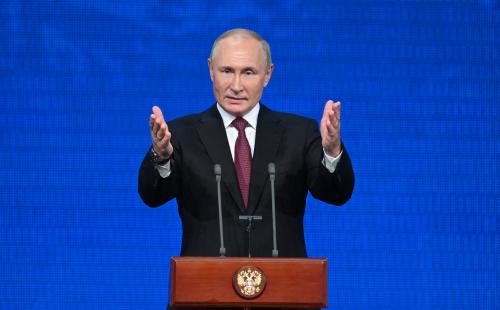In the thickly populated firmament of regional bodies, a new star is born: the Latin American and Caribbean Community of States. In Cancun today, 32 heads of state from Latin America and the Caribbean announced their intention to create a regional organization, whose only clear feature so far is that it will exclude the U.S. and Canada. It is easy to dismiss this remarkable show of unity as a good photo opp and little else. After all, a veritable shouting match between Colombia’s President Alvaro Uribe and Venezuela’s strongman Hugo Chávez preceded the announcement, a quarrel that may accurately reflect the ideological rifts that are becoming all too visible throughout the region these days. Yet, the joint announcement points to real changes taking place in the region.
The idea of creating a new regional body to replace the Organization of American States (OAS) has been repeatedly floated in South America in the recent past, particularly by Chávez. It had not gotten off the ground until now. The fact that President Felipe Calderón of Mexico came out so strongly in support suggests that the idea is getting some real traction and that the Mexicans don’t want the new body to be controlled by either Brazil or worse by Chavez. After a long inward-looking lull, the Mexicans –a key diplomatic player in the region for much of the 20th century—seem to be flexing their muscles again.
While the OAS obituary has been written several times in the past, this time the challenge faced by the hemispheric body seems more serious than ever before. This does not really have to do with the OAS’s lackluster performance during the recent political crisis in Honduras, its loss of credibility as guarantor of the Inter-American Democratic Charter, and its pretty dysfunctional management, as reflected in the recent report on the OAS submitted to the U.S. Senate Committee on Foreign Relations. All this would be surmountable if there were real interest in fixing the OAS. Alas, some key actors in the region, notably Brazil, seem totally uninterested in the organization and are no longer betting on its future relevance. Brazil, whose current diplomatic clout is unprecedented, seems bent on redesigning the region’s institutional architecture in ways that reflect more clearly the hegemonic role that it sees itself playing in the future, particularly in South America. Other countries, such as Venezuela, are piggy-bagging for their own reasons on this very structural change.
Even the U.S. seems not terribly convinced on the future of the OAS as a relevant forum. They seem to be keener on investing their diplomatic energies in bolstering up their key bilateral relations with Brazil and Mexico. What about the rest of the region? Unless there is a specific and intense U.S. interest at stake in a particular circumstance, Washington seems reconciled to the idea of leaving the resolution of political disputes in Latin America to the Latin Americans themselves and to Brazil in particular.
Will the new outfit be a boon for Latin American integration? Will it become the embodiment of the dreams of Simón Bolívar, as claimed, with typical verbosity, by some of the voices present in Cancun? It is very doubtful. Despite today’s show, Latin American countries are too heterogeneous and too riddled with mutual distrust to be able to move effectively towards any kind of political integration. Meanwhile, economic integration, which is marginally more feasible, does not require grand projects, but very concrete initiatives. Let us be blunt: a four-lane highway between Colombia and Venezuela, or a high-tension electric grid linking Peru and Ecuador does far, far more for Latin American integration than 10 regional summits such as today’s.


Commentary
A (Dim) Star is Born in Latin America
February 23, 2010